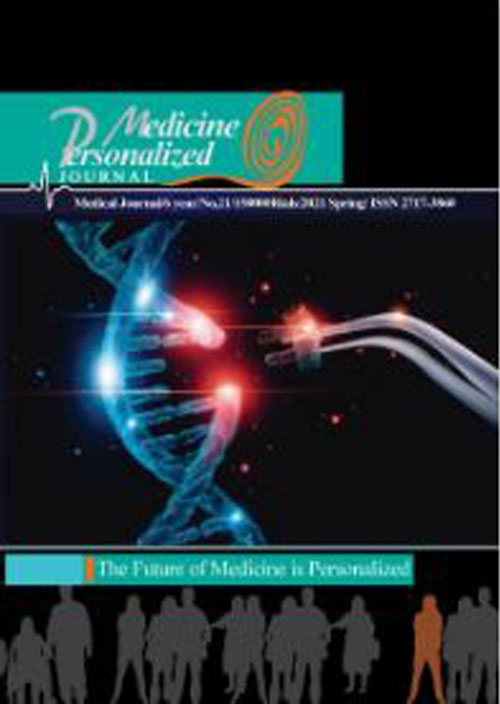فهرست مطالب

Personalized Medicine Journal
Volume:6 Issue: 21, Spring 2021
- تاریخ انتشار: 1400/05/11
- تعداد عناوین: 6
-
Pages 1-3Genetic studies, there is a potential association of RELN with some psychologicaldisorders such as Autism Spectrum Disorders (ASD) schizophrenia (SCZ). The RELNgene is located on chromosome 7q22.1 and encodes a large secretory protein of theextracellular matrix (Reelin). In the present case-control study, we intended to investigatethe relationship between the rs362746 polymorphism of RELN and schizophrenia in agroup of schizophrenic and healthy subjects from northeastern Iran.30 unrelated schizophrenic patients and 30 matched control subjects were recruited The samplesfrom the participants underwent PCR and sequencing for RELN genotype identification.he genotype distribution for both study and control groups were not in Hardy–Weinberg equilibrium(P>0.05).However, it was found that the prevalence ofrs362746 polymorphism was significantly different between the groups. the present study supported the evidence that rs362746 polymorphism of RELN was agenetic factor for schizophrenia susceptibility. However, there is a need for replicationstudies on different populations and further investigations on the sex-specific associationof this gene with schizophrenia.Keywords: Schizophrenia, Reelin gene, single nucleotide polymorphism, Sequencing
-
Pages 4-6Warning of the World Health Organization (WHO) indicates that novel coronavirus (COVID-19) is pandemic and causes global concern. COVID-19 has acute respiratory symptoms which leads to die in many cases through the world. We have found seven variants in 300 patients based on Next Generation Sequencing (NGS) which are related to infectious disease. According to the databases, we confirmed that rs2660 and rs1800450 have association with COVID-19 in the Iranian population.Keywords: COVID-19, Infection, NGS, Polymorphism
-
Pages 7-11
Severe Acute Respiratory SyndromeCoronavirus 2 (SARS-CoV-2), is a severe infection with respiratory and systemicmanifestations. This infectious disease has a complex course and manifests itself withvarious clinical presentations, ranging from asymptomatic infection to a severe clinicalcourse. These variations in severity have raised the question of whether the genetic orepigenetic variations have a role in COVID-19 susceptibility or severity, and that thesefactors can be used to predict the disease course. A whole-genome sequencing performedon 95 samples of SARS-CoV-2 identified 116 unique mutations, most of which weremissense and synonymous. Moreover, some studies have reported a relationship betweenthe COVID-19 severity and the genes ACE and TMPRSS2. The present review providesan overview of different genes that have been found to be implicated or related to thesusceptibility to COVID-19 or its severity.
Keywords: Covid19, ACE gene, TMPRSS2 gene, Infection -
Pages 12-16One of the key molecular mechanisms contributing to the metastatic progression is epithelial to mesenchymal transition (EMT), which drives invasion and migration of various cancer including breast cancer.During tumorigenesis, changes in EMT regulatory pathways lead to a loss of cellular adhesions, changes in the polarization of the cell and cytoskeleton, detachment, migration, intra-vasation, and survival in the vascular system; extravasation, and finally, metastasis.EMT is largely mediated by a core set of EMT-activating transcription factors. The master regulators of the EMT include many pathways, however the primary mediators of the EMT include signaling through TGF-, Notch and Wnt. The role of EMT in breast cancer has been demonstrated via numerous in vitro studies in normal and malignant mammary epithelial cells and via in vivo studies using mouse models of breast cancers. Studying the regulatory pathways of the EMT process can be used as a tool for cancer monitoring ,treatment and possible direct targets for new-combination anticancer personalized medicine.Keywords: Epithelial to mesenchymal transition, Breast cancer, Cell Signaling, Personalized Medicine
-
Pages 17-22
The discovery and production of (synthetic) antibiotics in the first half of the previous century has been one of medicine’s greatest achievements. The use of antimicrobial agents has reduced morbidity and mortality of humans and contributed substantially to human’s increased life span. The issue of antibiotic resistance has received considerable attention due to the problem of the emergence and rapid expansion of antibiotic-resistant pathogenic bacteria. Antibiotic resistance exhibited by bacteria can be intrinsic, acquired, or adaptive. Therefore, efforts to develop antibiotics and study mechanisms of resistance should be continuous, resilient and steady. In the following sections, we will focus on the molecular and biochemical mechanisms of bacterial resistance, illustrating specific situations that are often encountered in clinical practice.
Keywords: Antibiotic resistance, Bacteria, Horizontal Gene Transfer, Efflux pumps -
Pages 23-25In this article, the features of DNA-functionalized goldnanoparticles (GNRs), including the size-dependent color, the amount of conjugated DNA, and the fluorescence quenchers will be described. DNA and aptamer conjugated GNRs can be applied for producing the colorimetric and fluorescent biosensors to detect all types of disease markers including DNA, RNA, protein and other small molecular metabolites.The early phase of this work is performed in clean buffers and serum samples. DNA-conjugated GNRs delivery into the cells is recently used for intracellular diagnosis in personalized medicine. Simultaneously, DNA-functionalized GNRs can be used to deliver the antisense DNA for gene therapy applications.With targeting both diagnosis and treatment applications, DNA- functionalized GNRs can be used as a suitable approach to reach theranostics purposes (diagnosis and treatment in a simultaneous manner).Keywords: GNRs, Aptamers, Biosensors, Fluorescence, Metabolites, Personalized Medicine

